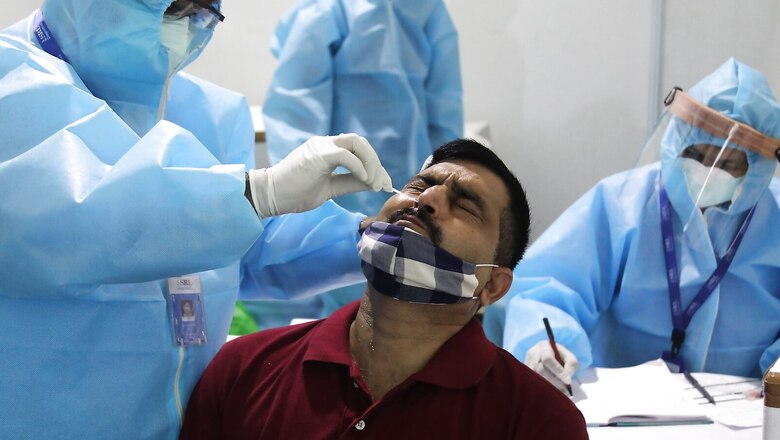
views
The Narendra Modi government’s emergency funding for tackling the Covid-19 pandemic has quadrupled in the ongoing financial year as states and union territories proposed to spend higher budgets on strengthening healthcare facilities, data shows.
On April 5, 2020, to bolster health systems and provide an immediate response to the pandemic, the central government had announced the India Covid-19 Emergency Response and Health System Preparedness Package, also known as the Emergency Covid-19 Response Plan (ECRP).
The objective of the fund was to build resilient health systems to address not only the Covid crisis but also manage future outbreaks. The money was allocated to states, UTs via the National Health Mission (NHM) as the nodal body for the scheme’s implementation.
According to the government data collated by the Accountability Initiative at Centre for Policy Research (CPR), a New Delhi-based think tank, of the 25 states and UTs for whom data was available, demand and government’s allocation both increased more than 300% to tackle the pandemic via emergency funding.
In the financial year 2020-21 – when the fund was introduced – the states and union territories had proposed to seek a budget of Rs 4,451 crore, of which 94 per cent – Rs 4,193 crore – was approved by the Centre.
In the next financial year, 2021- 22, when Indian states had fairly experienced the pandemic during the peak of the first wave in September and understood the major requirements, they hiked the amount proposed by over four times to Rs 21,460 crore.
The Centre also approved the increased amount and Rs 17,860 crore was sanctioned.
While the states and UTs had proposed almost 400% more than the previous fiscal, the government approvals also hiked the sanctioned amount to more than 300%.
Dearth of data
Experts welcome the focus on strengthening the healthcare infrastructure despite it being affected by the pandemic, but the data to show the on-ground impact of the increased funding is missing.
“The recent emphasis on health system strengthening is welcome especially given the pandemic,” Avani Kapur, fellow, CPR and lead at Accountability Initiative, told News18.com. “Unfortunately, Rural Health Statistics data for 2021 is not available to know the impact of this increased funding.”
The latest data available is from March 2020.
“Surprisingly too, revised estimates in this fiscal year, i.e., FY 2021-22, for Health System Strengthening within NHM fell by 3 per cent,” she further pointed out.
States to focus on healthcare
Broadly, the amount from the emergency budget can be divided into expenditure on Covid-19 diagnostics and drugs, health facilities, human resources and incentives. It can also be distributed towards information technology (IT) systems, information education communication/behaviour change communication (IEC/BCC), capacity building and training, and miscellaneous, which includes untied funds for districts and items not covered by the other categories.
The analysis of CPR shows that out of the total amount proposed for Covid-19 expenditure across states and UTs in FY 2020-21, more than half of the budget (54%) was proposed for Covid diagnostics and drugs followed by 13% for human resources, 12% for health facilities, and 8% for incentives.
However, the component-wise distribution of the proposed amounts changed in the next fiscal, 2021-22, as states learnt the importance of well-built and well-maintained healthcare facilities.
The data shows that the expenditure on health facilities became the priority of the states and UTs with 72% of proposals submitted for this category while seeking allocation for the financial year 2021-22.
After health facilities, the priorities were Covid-19 diagnostics and drugs (18 per cent), additional human resources (5 per cent), and IT systems (5 per cent).
Top states demanding higher allocation towards health facilities
In FY 2020-21, Andhra Pradesh prioritised Covid-19 diagnostics and drugs (74 per cent). This figure was reduced to 9 per cent in FY 2021-22, as they proposed a higher budget for health facilities. The state increased its demand for healthcare facilities from 14% to 67% of the annual emergency funding.
Similarly, in FY 2020-21, Odisha prioritised human resources with 62% of total funds whereas Karnataka prioritised IEC/BCC with 51% fund support.
However, next year, Odisha’s priority for HR was reduced to just 3% and Karnataka’s IEC/BCC support fell to zero. The priority shifted to health facilities.
These states, Odisha and Karnataka, opted to invest more in health facilities by proposing 71% and 73% of total shares, respectively.
Following the same trend, Uttar Pradesh in 2020-21 had proposed only 5% of its ERCP budget for health facilities which was stretched to 63%, a year later.
Meghalaya had also proposed to allocate 25% of its budget for Covid-19 to the health facilities, which next year zoomed to 68%. Bihar also doubled its requirement from 30% to 60%.
Read all the Latest News India and Breaking News here



















Comments
0 comment